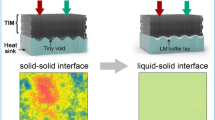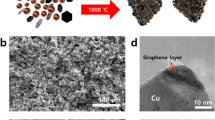Abstract
With the continuous advancements in electronics towards downsizing and integration, efficient thermal dissipation from chips has emerged as a critical factor affecting their lifespan and operational efficiency. The fan-less chip cooling system has two critical interfaces for thermal transport, which are the contact interface between the base and the chip dominated by thermal conduction, and the surface of the fins dominated by thermal radiation. The different thermal transfer modes of these two critical interfaces pose different requirements for thermal management materials. In the study, a novel approach was proposed by developing graphene thermal transport functional material whose morphology could be intentionally designed via reformed plasma-enhanced chemical vapor deposition (PECVD) methods to meet the diverse requirements of heat transfer properties. Specifically, graphene with multilevel branching structure of vertical graphene (BVG) was fabricated through the hydrogen-assisted PECVD (H2-PECVD) strategy, which contributed a high emissivity of ∼ 0.98. BVG was deposited on the fins’ surface and functioned as the radiation enhanced layer to facilitate the rapid radiation of heat from the heat sinks into the surrounding air. Meanwhile, the well-oriented vertical graphene (OVG) was successfully prepared through the vertical electric field-assisted PECVD process (EF-PECVD), which showed a high directional thermal conductivity of ∼ 53.5 W·m−1·K−1. OVG was deposited on the contact interface and functioned as the thermal conduction enhanced layer, allowing for the quick transmission of heat from the chip to the heat sink. Utilizing this design concept, the two critical interfaces in the chip cooling system can be jointly enhanced, resulting in a remarkable cooling efficiency enhancement of ∼ 30.7%, demonstrating that this novel material possessed enormous potential for enhancing the performance of cooling systems. Therefore, this research not only provided new design concepts for the cooling system of electronic devices but also opened up new avenues for the application of graphene materials in thermal management.

Similar content being viewed by others
References
Li, S.; Zheng, Q. Y.; Lv, Y. C.; Liu, X. Y.; Wang, X. Q.; Huang, P. Y.; Cahill, D. G.; Lv, B. High thermal conductivity in cubic boron arsenide crystals. Science 2018, 361, 579–581.
Cho, J.; Goodson, K. E. Cool electronics. Nat. Mater., 2015, 14, 136–137.
Garimella, S. V.; Yeh, L. T.; Persoons, T. Thermal management challenges in telecommunication systems and data centers. IEEE Trans. Compon. Packag. Manuf. Technol. 2012, 2, 1307–1316.
Weng, Y. Z. W.; Wu, S. C.; Wang, L. B.; Zhao, W. Y.; Jiang, Y.; Deng, Y. An efficient cooling solution with 3D interconnected graphene architectures for passive heat dissipation. J. Mater. Chem. C 2022, 10, 13167–13173.
Balandin, A. A. Thermal properties of graphene and nanostructured carbon materials. Nat. Mater. 2011, 10, 569–581.
Novoselov, K. S.; Fal’ko, V. I.; Colombo, L.; Gellert, P. R.; Schwab, M. G.; Kim, K. A roadmap for graphene. Nature 2012, 490, 192–200.
Qi, Y.; Sun, L. Z.; Liu, Z. F. Super graphene-skinned material: A new member of graphene materials family. Acta Phys. Chim. Sin. 2023, 39, 22–30.
Liu, R. J.; Yuan, H.; Li, J. L.; Huang, K. W.; Wang, K.; Cheng, Y.; Cheng, S. T.; Li, W. J.; Jiang, J.; Tu, C. et al. Complementary chemical vapor deposition fabrication for large-area uniform graphene glass fiber fabric. Small Methods 2022, 6, 2200499.
Zhou, M. F.; Xu, X. F.; Wan, G. P.; Mou, P. P.; Teng, S. J.; Wang, G. Z. Rationally tailoring interface characteristics of ZnO/amorphous carbon/graphene for heat-conduction microwave absorbers. Nano Res. 2022, 15, 8677–8687.
Wei, Q. Y.; Li, L.; Deng, Z.; Wan, G. P.; Zhang, Y.; Du, C. L.; Su, Y. R.; Wang, G. Z. Scalable fabrication of nacre-structured graphene/polytetrafluoroethylene films for outstanding EMI shielding under extreme environment. Small 2023, 19, 2302082.
Wu, Z. H.; Xu, C.; Ma, C. Q.; Liu, Z. B.; Cheng, H. M.; Ren, W. C. Synergistic effect of aligned graphene nanosheets in graphene foam for high-performance thermally conductive composites. Adv. Mater. 2019, 31, 1900199.
An, F.; Li, X. F.; Min, P.; Li, H. F.; Dai, Z.; Yu, Z. Z. Highly anisotropic graphene/boron nitride hybrid aerogels with long-range ordered architecture and moderate density for highly thermally conductive composites. Carbon 2018, 126, 119–127.
Xu, S. C.; Wang, S. S.; Chen, Z.; Sun, Y. Y.; Gao, Z. F.; Zhang, H.; Zhang, J. Electric-field-assisted growth of vertical graphene arrays and the application in thermal interface materials. Adv. Funct. Mater. 2020, 30, 2003302.
Yan, Q. W.; Alam, F. E.; Gao, J. Y.; Dai, W.; Tan, X.; Lv, L.; Wang, J. J.; Zhang, H.; Chen, D.; Nishimura, K. et al. Soft and self-adhesive thermal interface materials based on vertically aligned, covalently bonded graphene nanowalls for efficient microelectronic cooling. Adv. Funct. Mater. 2021, 31, 2104062.
Yuan, H.; Zhang, H.; Huang, K. W.; Cheng, Y.; Wang, K.; Cheng, S. T.; Li, W. J.; Jiang, J.; Li, J. L.; Tu, C. et al. Dual-emitter graphene glass fiber fabric for radiant heating. ACS Nano 2022, 16, 2577–2584.
Cheng, Y.; Cheng, S. T.; Chen, B. B.; Jiang, J.; Tu, C.; Li, W. J.; Yang, Y. Y.; Huang, K. W.; Wang, K.; Yuan, H. et al. Graphene infrared radiation management targeting photothermal conversion for electric-energy-free crude oil collection. J. Am. Chem. Soc. 2022, 144, 15562–15568.
Wang, K.; Cheng, S. T.; Yang, J. W.; Cheng, Y.; Ci, Q.; Yuan, H.; Huang, K. W.; Liu, R. J.; Li, W. J.; Li, J. L. et al. Bush-shaped vertical graphene/nichrome wire for blackbody-like radiative heating. Adv. Funct. Mater. 2022, 32, 2208785.
Mou, P. P.; Wan, G. P.; Wu, L. H.; Liu, D. S.; Wang, G. Z. Optimizing impedance matching and interfacial characteristics of aromatic polyimide/graphene by molecular layer deposition for heat-conducting microwave absorption. J. Mater. Chem. A 2023, 11, 4345–4354.
Liang, Q. Z.; Yao, X. X.; Wang, W.; Liu, Y.; Wong, C. P. A three-dimensional vertically aligned functionalized multilayer graphene architecture: An approach for graphene-based thermal interfacial materials. ACS Nano 2011, 5, 2392–2401.
Shen, X.; Wang, Z. Y.; Wu, Y.; Liu, X.; He, Y. B.; Kim, J. K. Multilayer graphene enables higher efficiency in improving thermal conductivities of graphene/epoxy composites. Nano Lett. 2016, 16, 3585–3593.
Renteria, J. D.; Ramirez, S.; Malekpour, H.; Alonso, B.; Centeno, A.; Zurutuza, A.; Cocemasov, A. I.; Nika, D. L.; Balandin, A. A. Strongly anisotropic thermal conductivity of free-standing reduced graphene oxide films annealed at high temperature. Adv. Funct. Mater. 2015, 25, 4664–1672.
Suryawanshi, C. N.; Kim, T.; Lin, C. T. An instrument for evaluation of performance of heat dissipative coatings. Rev. Sci. Instrum. 2010, 81, 035105.
Strnad, J.; Vengar, A. Stefan’s measurement of the thermal conductivity of air. Eur. J. Phys. 1984, 5, 9–12.
Suryawanshi, C. N.; Lin, C. T. Radiative cooling: Lattice quantization and surface emissivity in thin coatings. ACS Appl. Mater. Interfaces 2009, 1, 1334–1338.
Zhang, G.; Jiang, S. H.; Zhang, H.; Yao, W.; Liu, C. H. Excellent heat dissipation properties of the super-aligned carbon nanotube films. RSC Adv. 2016, 6, 61686–61694.
Cheng, S. T.; Chen, M.; Wang, K.; Liu, Q. Q.; Cheng, Y.; Dong, R. H.; Huang, K. W.; Yuan, H.; Jiang, J.; Li, W. J. et al. Multifunctional glass fibre filter modified with vertical graphene for one-step dynamic water filtration and disinfection. J. Mater. Chem. A 2022, 10, 12125–12131.
Pan, D.; Yang, G.; Abo-Dief, H. M.; Dong, J. W.; Su, F. M.; Liu, C. T.; Li, Y. F.; Bin Xu, B.; Murugadoss, V.; Naik, N. et al. Vertically aligned silicon carbide nanowires/boron nitride cellulose aerogel networks enhanced thermal conductivity and electromagnetic absorbing of epoxy composites. Nano-Micro Lett. 2022, 14, 118.
Malesevic, A.; Vitchev, R.; Schouteden, K.; Volodin, A.; Zhang, L.; Tendeloo, G. V.; Vanhulsel, A.; Haesendonck, C. V. Synthesis of few-layer graphene via microwave plasma-enhanced chemical vapour deposition. Nanotechnology 2008, 19, 305604.
Zhu, M. Y.; Wang, J. J.; Holloway, B. C.; Outlaw, R. A.; Zhao, X.; Hou, K.; Shutthanandan, V.; Manos, D. M. A mechanism for carbon nanosheet Formation. Carbon 2007, 45, 2229–2234.
Zhao, J.; Shaygan, M.; Eckert, J.; Meyyappan, M.; Rümmeli, M. H. A growth mechanism for free-standing vertical graphene. Nano Lett. 2014, 14, 3064–3071.
Wang, K.; Cheng, S. T.; Hu, Q. M.; Yu, F.; Cheng, Y.; Huang, K. W.; Yuan, H.; Jiang, J.; Li, W. J.; Li, J. L. et al. Vertical graphene-coated Cu wire for enhanced tolerance to high current density in power transmission. Nano Res. 2022, 15, 9727–9733.
Zhang, H.; Wu, S. D.; Lu, Z. Y.; Chen, X. C.; Chen, Q. X.; Gao, P. Q.; Yu, T. B.; Peng, Z. J.; Ye, J. C. Efficient and controllable growth of vertically oriented graphene nanosheets by mesoplasma chemical vapor deposition. Carbon 2019, 147, 341–347.
Yu, W.; Duan, Z.; Zhang, G.; Liu, C. H.; Fan, S. S. Effect of an auxiliary plate on passive heat dissipation of carbon nanotube-based materials. Nano Lett. 2018, 18, 1770–1776.
Zhang, G.; Jiang, S. H.; Yao, W.; Liu, C. H. Enhancement of natural convection by carbon nanotube films covered microchannel-surface for passive electronic cooling devices. ACS Appl. Mater. Interfaces 2016, 8, 31202–31211.
Zhu, J.; Tang, D. W.; Wang, W.; Liu, J.; Holub, K. W.; Yang, R. G. Ultrafast thermoreflectance techniques for measuring thermal conductivity and interface thermal conductance of thin films. J. Appl. Phys. 2010, 108, 94315.
Sun, F. Y.; Wang, X. W.; Yang, M.; Chen, Z.; Zhang, H.; Tang, D. W. Simultaneous measurement of thermal conductivity and specific heat in a single TDTR experiment. Int. J. Thermophys. 2018, 39, 5.
Ping, L. Q.; Hou, P. X.; Liu, C.; Li, J. C.; Zhao, Y.; Zhang, F.; Ma, C. Q.; Tai, K. P.; Cong, H. T.; Cheng, H. M. Surface-restrained growth of vertically aligned carbon nanotube arrays with excellent thermal transport performance. Nanoscale 2017, 9, 8213–8219.
Eyassu, T.; Hsiao, T. J.; Henderson, K.; Kim, T.; Lin, C. T. Molecular cooling fan: Factors for optimization of heat dissipation devices and applications. Ind. Eng. Chem. Res. 2014, 53, 19550–19558.
Yu, W.; Zhang, G.; Liu, C. H.; Fan, S. S. Hard carbon nanotube sponges for highly efficient cooling via moisture absorption-desorption process. ACS Nano 2020, 14, 14091–14099.
Yu, W.; Liu, C. H.; Fan, S. S. High water-absorbent and phase-change heat dissipation materials based on super-aligned cross-stack CNT films. Adv. Eng. Mater. 2019, 21, 1801216.
Teng, T. P.; Teng, T. C. Enhance heat dissipation for projection lamps by MWCNTs nano-coating. Appl. Therm. Eng. 2013, 51, 1098–1106.
Wang, S. Q.; Wang, Y. M.; Zou, Y. C.; Chen, G. L.; Ouyang, J. H.; Jia, D. C.; Zhou, Y. Biologically inspired scalable-manufactured dual-layer coating with a hierarchical micropattern for highly efficient passive radiative cooling and robust superhydrophobicity. ACS Appl. Mater. Interfaces 2021, 13, 21888–21897.
Zou, Y. C.; Wang, Y. M.; Wei, D. Q.; Ge, Y. L.; Ouyang, J. H.; Jia, D. C.; Zhou, Y. Facile one-step fabrication of multilayer nanocomposite coating for radiative heat dissipation. ACS Appl. Electron. Mater. 2019, 1, 1527–1537.
Cai, Y.; Yu, H. T.; Chen, C.; Feng, Y. Y.; Qin, M. M.; Feng, W. Improved thermal conductivities of vertically aligned carbon nanotube arrays using three-dimensional carbon nanotube networks. Carbon 2022, 196, 902–912.
Acknowledgements
This work was financially supported by the National Natural Science Foundation of China (Nos. 52272032, T2188101, and 52021006) and the Beijing Nova Program of Science and Technology (No. 20220484079).
Author information
Authors and Affiliations
Corresponding authors
Electronic Supplementary Material
12274_2024_6540_MOESM1_ESM.pdf
Co-enhancement of thermal conduction and radiation through morphologies controlling of graphene functional layer for chip thermal management
Rights and permissions
About this article
Cite this article
Cheng, S., Wang, K., Xu, S. et al. Co-enhancement of thermal conduction and radiation through morphologies controlling of graphene functional layer for chip thermal management. Nano Res. (2024). https://doi.org/10.1007/s12274-024-6540-6
Received:
Revised:
Accepted:
Published:
DOI: https://doi.org/10.1007/s12274-024-6540-6




